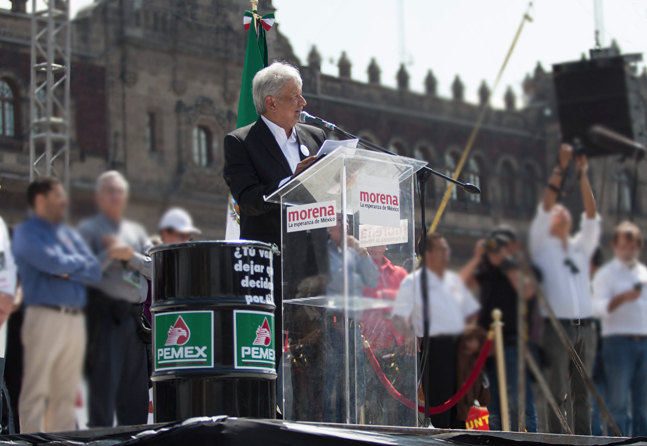The most surprising result from the previous mid-term elections in Mexico was the apparent divorce between Andrés Manuel López Obrador (AMLO) and the voter in Mexico City (abbreviated as CDMX). More than half of its territorial divisions passed into the hands of the opposition, painting an electoral map of the city split in two: the opposition in the west, the ruling party in the east. The defeat in the country’s capital was painful for AMLO for two reasons. First, it’s because CDMX is where his political career initially took off. Second, the defeat has left his political goddaughter and current mayor, Claudia Sheinbaum, in an unfavorable position.
Their reaction was one of initial disbelief and then denial. How is it possible that the city they think of as leftist could have voted for right-wing parties? This shows that they do not know where they stand: CDMX does not have a left-wing inclination but an opposition one.
AMLO owes it to CDMX
To begin with, we must illustrate the importance of the CDMX in AMLO’s political career. The capital city is where the current president studied for his degree in Political Science. It was there where he arrived from his native state of Tabasco with his family in 1996 to lead the leftist Party of the Democratic Revolution (PRD), his first position at the national level. From that position, he built his candidacy for the post of Chief of Government of the then Federal District (DF) in 2000, without having to meet the five-year residency requirement.
From the first day of his administration, he used the spotlight and the resources of the office to position himself politically with his sights set on the presidency. His strategy was simple: to fight every day with the federal government of the right-wing National Action Party (PAN) headed by Vicente Fox (2000-2006), even if it was over minor trifles such as the summer timetable.
In this way, AMLO transformed the Mexico City Government Office into the beachhead of the opposition to the federal government. The most heated confrontation between the two levels of government occurred in 2005 when Fox clumsily tried to knock AMLO out of the presidential race. The city then threw its weight behind its mayor and supported him with massive mobilizations that forced Fox to back down.
But AMLO would pay them back with ingratitude. After losing the 2006 elections against Felipe Calderón, he accused fraud and sent his followers to block Reforma Avenue as an attempt to cancel the elections. Overnight, the capital’s most elegant avenue was beaten with sledgehammers and spades to set up stalls where his supporters stood guard to force the breakdown of constitutional order. The economic losses for businessmen, shopkeepers, employees, and restaurateurs in the area were calculated at 7 billion pesos. This is without mentioning the dismissal of more than three thousand workers.
The 2012 presidential elections came and the city forgave AMLO for his 2006 outburst by voting massively for him again. On this occasion, he defeated the opposing candidate of the election, Enrique Peña Nieto of the Institutional Revolutionary Party (PRI), by a ratio of two votes to one in the city. However, AMLO again claimed there was fraud. However, this time the difference in votes did not give him the strength to carry out mobilizations as in 2006.
The story of AMLO and the CDMX would not end there. In 2014 he founded his own personal party in the capital, the National Regeneration Movement (MORENA), with which he swept the 2018 elections, not only in the city but in the entire country. Note that MORENA is a party created in the CDMX, not in Tabasco or in any other state of the republic.
The loss of the CDMX
All of the above explains why the loss of space in the capital was so painful for AMLO, and why he has been insulting the middle classes of the capital for weeks for turning their backs on him. He is driven not only by wounded pride but also by political calculation: MORENA’s presidential candidate in pectore for 2024, Mayor Sheinbaum, was badly hurt by the electoral results.
Sheinbaum is a politician with a cold and academic style that contrasts with the president’s hot-bloodedness, but she has won his affection for her absolute loyalty, something the president values above all else. The results, however, showed that his delfinacy and enthronement are no easy task.
The problem with AMLO and Sheinbaum is that they refuse to see reality. Their many years in power have made them believe that the city is “leftist”. They are wrong, the CDMX has an affinity for the opposition. AMLO and Sheinbaum confuse one thing with the other.
Moreover, this affinity for the opposition is not new. During the era of PRI authoritarianism in the twentieth century, the city was always the bastion of opposition parties, both right and left. Already in 1976, during the PRI’s heyday, the votes for the opposition in the CDMX were triple the national average. The same can be said after the democratic transition (1976-1996).
The PRD governments of Cuauhtémoc Cárdenas (1997-2000), AMLO (2000-2005), Marcelo Ebrard (2006-2012), and Miguel Mancera (2012-2018) were always seen as “opposition governments” (an oxymoron that is in common use in Mexico). These governments had the support of the city’s citizenry that saw in them a healthy counterweight to the federal government of the PAN and later the PRI. Why should things be any different now?
With the results of last June, the CDMX is once again the epicenter of the opposition to the federal government. This new reality has been very difficult to accept for AMLO, who today considers himself an opponent to the power of the elites. His problem is that people, especially the people of the capital, see him less and less as an opponent and more as what he is: an authority. An authority, moreover, by the way, that offers a lot of politics, but few results.
Translated from Spanish by Alek Langford
Autor
Cientista político y economista. Doctor por la Universidad de Toronto. Editor Senior en Global Brief Magazine. Especialista en Diseño de Investigación Social en RIWI Corp. (Real-Time Interactive World-Wide Intelligence).











